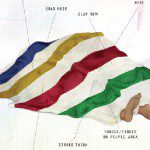Whip It Out
Sex sells. And that's why you'll be hard-pressed to find much discussion of serious issues amidst the soft-core porn in Canada's gay press
A model leans on the kitchen counter of photographer Lindsay Lozon’s studio waiting to be shot for fab. He wears only hot-pink briefs with black polka dots from Seduction Erotic Boutique, a thick white belt, a slim tie, a wristband, Kangol sneakers, and a straight face. The muscles on his lean, hairless body are accentuated by glistening body makeup.
“Are we supposed to be like dolls, literally?” he asks.
That’s exactly what he’s supposed to look like on the cover of the gay magazine’s holiday gift-guide issue. He has been styled to look like a Barbie doll, complete with black lines that trace his kneecaps and the joints where his arms and legs meet his torso. The theme of the issue is “Boy Toys,” and the name of his shot is “Warhol Willy.” The model is tied to a background with images of Andy Warhol’s yellow bananas. His bondage has the effect of a squeaky-clean Barbie in her packaging. The model wears thick black-rimmed glasses, and his hair is sculpted like Warhol’s in his 1986 Self-Portrait.
fab and other major gay magazines in Canada are known for their in-your-face use of sex. While the sex is most explicit in the ads, it’s also found in the stories. Editors of Canada’s three most-read gay publications – Xtra, fab, and fugues (all of which target mainly gay men) – dress up their articles with titillating pull-quotes, sexually suggestive headlines, and racy photos. While little of the actual content is about sex, a casual flip-through makes them appear almost pornographic. Unfortunately, the oversexed veneer compensates for the lack of great writing in gay publications – something they don’t have the industry-standard budget to consistently achieve. But what is most troubling about the sex-heavy nature of gay media is how it reinforces the idea of gay culture as hyper-sexualized. It doesn’t do much for the publications’ journalistic credibility either. Readers can hardly be expected to take an article about same-sex marriage seriously when it’s positioned under a suggestive headline and next to an ad featuring a half-naked man. And that’s too bad, particularly at a time when gay rights are being debated more than ever before and the gay press could – should – be spearheading the coverage.
I became aware of how obsessed gay media are with sex when a salacious headline was tacked on to a profile I wrote for Xtra this past October. The story was about an Aboriginal woman and the challenges she had overcome in her life. The headline was “I’m a slut.” And while my subject did say that and I included it in my story, her sluttiness was not the focus of the piece. Managing editor Paul Gallant says he used that quote because it was a “strong and empowered sexual statement.” Moreover, he thought it would entice people to read the piece. Maybe, but it set the wrong tone from the get-go, shamelessly cashing in on the one mention of the profile subject’s sex life in the whole piece. Unfortunately, my experience is not an isolated incident – all too often, gay media sex up their stories with steamy images and display copy in order to grab readers’ attention, which is a big change from 30 years ago, when the gay press got its start in Canada, and sex took a backseat to politics.
The gay press today serves a different role than the groundbreaking, politics-driven gay media of the 1970s. Richard Burnett, the author of the gay column “Three Dollar Bill” in Montreal’s Hour and a columnist for fugues, says that nowadays, many gays and lesbians take their rights for granted, and that is reflected in today’s lifestyle-oriented gay press. “It’s not about what bars were raided, but when Will [from Will & Grace] will kiss the other guy,” he says. “It was more about radical politics back then.” Burnett says gay publications now do for gay people in a given region what weekly newspapers do for their communities – they provide a smattering of local news and event listings, but, more than that, a feeling of connectedness to their neighbours. In contrast, The Body Politic, the gay liberationist paper published from 1971 to 1987, not only reported on topics of interest to gay people, but was part of the gay movement. An example of how this played out happened in the spring of 1973. When The Toronto Star bought the company that printed the Body Politic and then refused to print its eighth issue, the paper found another printer and wrote a story about what had happened. The story, “Why 8’s late,” ran with shots of a demonstration by the members of the Body Politic collective outside the Star’s office. That episode with the printer, in conjunction with homophobic responses from the newspaper’s management, prompted members of the collective to picket the home of the Star’s publisher. It would be shocking to see this type of activist response from the staff of the gay papers today. But, as Burnett says, times have changed.
In 1984, Pink Triangle Press launched Xtra, a free semimonthly tabloid to help bolster lagging sales of the Body Politic. The politics in Xtra were meant to be the same as in the Body Politic, except in “more edible bits,” says Rick Bébout, a former member of the collective that created Xtra. With an audited circulation of 45,000, it is now the country’s most-read English gay publication. “The politics have been reduced,” says Bébout, comparing Xtra to the Body Politic. “The piece that is missing is liberation. The sex radicalism of the paper is still a good thing, but it’s the only thing left.” In explaining the abundance of sex in his paper, Gallant refers to part of Pink Triangle Press’s mission statement, which reads “[to] honour lust and seek a world where sex is valued as a human trait, no more no less than any other.” But by picking up your local Xtra, you’d think sex was more the be-all and end-all of gay culture than something simply valued.
Ken Popert, a member of the Body Politic collective and the current president and executive director of Pink Triangle Press, says sex is used in Xtra for specific reasons, such as challenging readers to think about why something, like a photo, irritates or upsets them. He gives the example of how Xtra once got into a fight with its printer over a safer-sex ad that showed one man kneeling in front of another, apparently giving him a blow job. Xtra printed a story about the printer’s refusal to print the ad, in an apparent stand against the “rising tide of filth.” (It reproduced the ad after Popert reminded the printer that refusing to do so contradicted the Charter of Rights and Freedoms.) The purpose of running the photo, says Popert, was to invite readers to compare their reactions to that of the printer’s, and to think about why it was a good image to use to educate gay men about safer sex. Popert calls this use of sex “purposeful and constructive provocation.” That may be so, but another reason for all the sex in Xtra appears to be to bait people into picking up the paper because the writing isn’t incentive enough.
Gerald Hannon, an early member of the Body Politic collective and a current director of Pink Triangle Press, reads Xtra and fab, but says his real pleasure comes from magazines such as The New Yorker, Harper’s Magazine, and This Magazine. “I like good writing better than I like stuff about matters gay,” he says. “And there’s not a lot of great writing in gay media.” When asked about the writing in his paper, Gallant says Xtra works on a tight budget. “Any editor would rather offer a writer $1,000 for a story than a hundred,” he says, but that isn’t an option for him. Regardless, he says writers are lured to Xtra because they want to feel a connection to gay people in their city, and Xtra is one of the few gay publications out there. “Sometimes well-known writers will write for us and not even expect to get paid,” he says.
Over at fab, Xtra’s biggest competitor, editor-in-chief Mitchel Raphael has done a decent job of obtaining occasional pieces by major writers such as Christie Blatchford, Jeanne Beker, and John Bentley Mays. Since taking over as editor in April 2002, Raphael, a former reporter at the National Post and the Star, says he offers competitive rates and has no problem finding big-name writers. However, fab doesn’t pay the established $1 per word for its articles, an economic benchmark of today’s magazine industry. The majority of the magazine consists of columns that report on Toronto’s gay scene, the magazine’s raison d’être. A glossy-covered magazine with newsprint on the inside, fab began publishing 10 years ago. Today, the semimonthly has an audited circulation of 30,000 in Ontario. Under Raphael’s direction, circulation is up by almost one-third, and ad sales are also rising. But whether that’s due to the magazine’s sexy outside or the writing inside is hard to discern.
Publisher Michael Schwarz credits Raphael for giving fab a sexier look, producing many memorable covers, such as Toronto mayor David Miller in a leather biker jacket or former Toronto police Chief Julian Fantino surrounded by male models impersonating the Village People. For his own reading pleasure, Raphael says he doesn’t need a sexy cover to get him to open a magazine. But he knows if he doesn’t dress up an article in the right way, he’ll have a limited audience, so he uses sex to grab his readers, 61 per cent of whom are between the ages of 25 and 34. He says his goal is to attract readers to meaty issues they otherwise wouldn’t engage in, such as the prejudices gay seniors face. He gives the example of the article, “Did club culture kill the gay dinner party?” by Alex Rowlson, a piece on the rise and fall of the gay dinner party. The cover photo is of a man at a dinner table wearing an open blazer that exposes his muscular chest, and one of the images inside is of the model lying across the dinner table, naked, but for a bunch of grapes covering his genitals. “You need to sell that story,” says Raphael. “I’m not going to have Alex write [more than 6,000] words and then have a photo of a beautiful turkey. People aren’t going to wonder, ‘How did they make that cranberry sauce?'”
In fab, the images are not the only things that scream sex; the display copy is often sexually suggestive. You wouldn’t guess it by leafing through a current issue, but the display copy has been gradually sanitized, according to fab’s associate and literary editor Andrea Németh. “Now we only sometimes have the dirtiest thing possible in the pull quotes,” says Németh. Raphael says that unlike Maxim, which uses sex to sell sex, fab uses sex to sell ideas. “I’m not going to say that every article is poetry or intellectual thought,” he says, “but there’s enough in there that it is.” Schwarz stresses that fab is not just about sex and says it runs some “really intellectual” articles.
Perhaps “really intellectual” doesn’t quite characterize the majority of the articles in fab, but some are. For example, in the holiday gift-guide issue, there’s an essay by Rinaldo Walcott about how “the culture of fag shopping” has become so central to many gay men. Even though the essay is not about sex, its two pull quotes – “A proud part of queer history has been servicing others” and “Buying is the orgasm of shopping” – are full of sexual innuendo. And while the sensational packaging often misleads readers as to what the stories are about, since few of the stories are actually about sex, Raphael says if it gets people to read about a prominent gay writer or the police chief’s views on the gay community, then misrepresentation is justified.
The portrayal of sex in gay publications works well for pick-up rates, but good journalism should be able to stand on its own, something fugues editor Yves Lafontaine has tried to put into practice. With an audited circulation of 50,000, fugues, which is about the size of an Archie comic, is the most-read French gay news publication in Canada. Surprisingly, it is a lot less sexual than it used to be. It started 21 years ago as a publicity vehicle for bathhouses, bars, and nude dancers. Since Lafontaine took over 11 years ago, he set out to concentrate less on sex and more on better writing. He also toned down the sexual imagery in the ads and the editorial content, mainly to attract more mainstream advertisers. Many fugues readers also asked for less explicit imagery in the ads and stories. “Readers said, ‘We don’t need to have naked men in all the advertisements and all the articles. We’re not sex-driven because we’re gay’,” says Lafontaine. Slowly, the magazine began to open its pages to other subjects. “We cover topics from pension plans to gardening to the new saunas that are opening. [Quebecers often refer to bathhouses as saunas.] But we talk about saunas as news,” he explains. “Not as an erotic thing.”
That’s encouraging to critics like Now Magazine‘s books and entertainment editor Susan G. Cole, who is troubled by the hyper-sexualized portrayal of gay culture in gay media. “Either the stuff is important to read and it’s good on its face, or it’s crap and the only way they can draw people into the magazine is to put across this other kind of image.” Cole doesn’t think it’s necessary to dress up articles to catch people’s interest, because gay people want to read about themselves. A lesbian mother of a 16-year-old, Cole says the public’s perception – influenced by the gay press – that the gay culture is pornographic has become problematic for people like her, who try to promote alternative families. “The biggest resistance to the idea of queer families comes from people who think that our kids are going to grow up in these households where everybody is running around just having sex and humping everything in sight,” she says. “They cannot see us outside the sexual frame.”
Raphael disagrees, arguing that if not for the sex in gay publications, nothing would make them uniquely publications for gay people. “How many places are there where you can discuss sex and sexuality for queer people other than in gay publications?” Not many, but just because you can do something, it doesn’t mean you should. No one’s arguing against the importance of discussing sex and sexuality, but doing so in excess furthers the stereotype of hyper-sexualized gays and lesbians and doesn’t say much for the writing in the publications.
For those gay people who do crave great writing, they don’t rely on gay publications to provide it. Sadly, the quality of the journalism in gay news publications isn’t destined to improve, and no one seems too concerned, because readers don’t pick up gay media for great journalism; they pick them up to read about themselves and for the club and event listings.
It seems that even if the writing were better, its credibility would still be questionable – especially to mainstream audiences – because of all the sex surrounding it. This means it will take a long time before anyone takes gay journalism seriously.
Back at the photo shoot in Lozon’s studio, the straight-faced model keeps sticking his hand in his hot-pink underwear and adjusting his genitals, while taking hauls from his cigarette.
“Are you supposed to be smoking in here?” asks Maha, the stylist hired to make the shoot look fabulous. He’s sporting a shirt that reads, “TRANSFORM BOYS INTO TOYS.”
“May I smoke?” asks the model.
“Yes. You may,” says Maha, who lights up his own cigarette a few minutes later.
Another few minutes pass before Maha asks the model, “Ready to be tied up?”
“I guess,” he answers.
“Perfect,” says Maha. “Come on, let’s do this.”
Maha then turns to me and says, “We can tie you up later so you’ll have a pic for your article.”












































